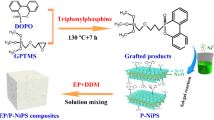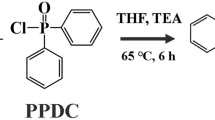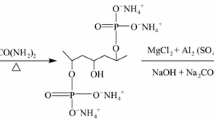Abstract
The flame retardancy of 2, 2-bis(4-glycidyloxyphenyl)propane (DGEBA)-aluminum diethylphosphinate (AlPi) nanocomposites (EP-AlPi/(P − x), x = 1, 2, 3 %) was greatly enhanced by ultrasonic dispersion of nano-sized AlPi into epoxy resin. The UL 94 V-0 rating can be reached for EP-AlPi nanocomposites with a relatively low addition amount of AlPi (on the account of 8.4 wt% or phosphorus content of 2 wt%) as well as the LOI value over 37.2. The glass transition temperature (T g) enhanced properties were investigated by DTA, which showed that: T gs were about 5 °C higher than that of neat epoxy resin; T g increased along with content increasing of AlPi. Based on TGA results under a non-isothermal condition, the thermal degradation kinetics of EP-AlPi/(P − x) composites were studied by Kissinger’s, Ozawa’s, Flynn–Wall–Ozawa’s and Coast-Redfern’s methods, which suggested the conversion function f (α) = 1/2α −1 or f (α) = [−ln(1 − α)]−1 for EP-AlPi/(P − 1 %); f (α) = [−ln(1 − α)]−1 for EP-AlPi/(P − 2 %) and EP-AlPi/(P − 3 %) during the investigated process. The epoxy resin nanocomposites obtained in this study are green functional polymers and will become flame retardant potential candidates in electronic fields such as printed wiring boards with high performance.











Similar content being viewed by others
References
D. Sun, Y. Yao, Synthesis of three novel phosphorus-containing flame retardants and their application in epoxy resins. Polym. Degrad. Stab. 96(10), 1720–1724 (2011)
C.S. Wang, J.Y. Shieh, Synthesis and properties of epoxy resins containing 2-(6-oxid-6H-dibenz < c, e > < 1, 2 > oxaphosphorin-6-yl) 1, 4-benzenediol. Polymer 39(23), 5819–5826 (1998)
S.V. Levchik, E.D. Weil, Thermal decomposition, combustion and flame-retardancy of epoxy resins—a review of the recent literature. Polym. Int. 53(12), 1901–1929 (2004)
L.J. Qian, L.J. Ye, G.Z. Xu et al., The non-halogen flame retardant epoxy resin based on a novel compound with phosphaphenanthrene and cyclotriphosphazene double functional groups. Polym. Degrad. Stab. 96(6), 1118–1124 (2011)
J.Y. Shieh, C.S. Wang, Synthesis of novel flame retardant epoxy hardeners and properties of cured products. Polymer 42(18), 7617–7625 (2001)
J. Gu, G. Zhang, S. Dong et al., Study on preparation and fire-retardant mechanism analysis of intumescent flame-retardant coatings. Surf. Coat. Technol. 201(18), 7835–7841 (2007)
J. Sun, X. Wang, D. Wu, Novel spirocyclic phosphazene-based epoxy resin for halogen-free fire resistance: synthesis, curing behaviors, and flammability characteristics. ACS Appl. Mater. Interfaces 4(8), 4047–4061 (2012)
B. Sood, M. Pecht, Conductive filament formation in printed circuit boards: effects of reflow conditions and flame retardants. J. Mater. Sci. Mater. Electron. 22(10), 1602–1615 (2011)
P. Fisk, A. Girling, R. Wildey, Prioritisation of Flame Retardants for Environmental Risk Assessment (Environment Agency, Wallingford, 2003)
X. Li, Y. Ou, Y. Shi, Combustion behavior and thermal degradation properties of epoxy resins with a curing agent containing a caged bicyclic phosphate. Polym. Degrad. Stab. 77(3), 383–390 (2002)
M. Iji, Y. Kiuchi, Flame resistant glass-epoxy printed wiring boards with no halogen or phosphorus compounds. J. Mater. Sci. Mater. Electron. 15(3), 175–182 (2004)
J. Xu, J. Liu, K. Li, Application of functionalized graphene oxide in flame-retardant polypropylene. J. Vinyl Addit. Technol. 21(4), 278–284 (2015)
M. Iji, Y. Kiuchi, Self-extinguishing epoxy molding compound with no flame-retarding additives for electronic components. J. Mater. Sci. Mater. Electron. 12(12), 715–723 (2001)
X. Li, Y. Liu, C. Guo, H. Liu, G. Wang, Q. Cai, Y. Yao, Influence of layered aluminoborophosphate on flame retardance, crystallization behaviors and mechanical properties of polyamide 66 systems. Chem. Res. Chin. Univ. 32(1), 127–133 (2016)
S.Y. Lu, I. Hamerton, Recent developments in the chemistry of halogen-free flame retardant polymers. Prog. Polym. Sci. 27(8), 1661–1712 (2002)
J. Xu, X. Zhou, C. Ye et al., Thermal stability and mechanical property of polyvinyl chloride/intercalated hydrotalcite. J. Chin. Ceram. Soc. 41(4), 516–520 (2013)
B.I. Noh, S.B. Jung, Characteristics of environmental factor for electrochemical migration on printed circuit board. J. Mater. Sci. Mater. Electron. 19(10), 952–956 (2008)
M. Wang, J. Xu, H. Wu et al., Effect of pentaerythritol and organic tin with calcium/zinc stearates on the stabilization of poly (vinyl chloride). Polym. Degrad. Stab. 91(9), 2101–2109 (2006)
L. Xiao, D. Sun, T. Niu et al., Syntheses and characterization of two novel 9, 10-dihydro-9-oxa-10-phosphaphenanthrene-10-oxide-based flame retardants for epoxy resin. High Perform. Polym. 26(1), 52–59 (2014)
K. Ramachandran, W.J. Ready, P.M. Raj et al., Insulation reliability of fine-pitch through-vias in glass fiber reinforced halogen-free epoxy substrates. J. Mater. Sci. Mater. Electron. 25(4), 1687–1695 (2014)
C.S. Wu, Y.L. Liu, Y.S. Chiu, Epoxy resins possessing flame retardant elements from silicon incorporated epoxy compounds cured with phosphorus or nitrogen containing curing agents. Polymer 43(15), 4277–4284 (2002)
T. Ohki, Q.Q. Ni, N. Ohsako et al., Mechanical and shape memory behavior of composites with shape memory polymer. Compos. A Appl. Sci. Manuf. 35(9), 1065–1073 (2004)
B.I. Noh, N.C. Park, W.S. Hong et al., Effect of underfill on bending fatigue behavior of chip scale package. J. Mater. Sci. Mater. Electron. 19(5), 406–410 (2008)
J. Cerny, G. Vivant, U.S. Patent No. 4,188,313 (U.S. Patent and Trademark Office, Washington, DC), 12 Feb 1980
J.S. Wang, Y. Liu, H.B. Zhao et al., Metal compound-enhanced flame retardancy of intumescent epoxy resins containing ammonium polyphosphate. Polym. Degrad. Stab. 94(4), 625–631 (2009)
Z. Yang, C. Zhou, H. Yang et al., Improvement of the compatibilization of high-impact polystyrene/magnesium hydroxide composites with partially sulfonated polystyrene as macromolecular compatibilizers. Ind. Eng. Chem. Res. 51(27), 9204–9212 (2012)
G.H. Hsiue, Y.L. Liu, J. Tsiao, Phosphorus-containing epoxy resins for flame retardancy V: synergistic effect of phosphorus-silicon on flame retardancy. J. Appl. Polym. Sci. 78(1), 1–7 (2000)
C.L. Gan, U. Hashim, Evolutions of bonding wires used in semiconductor electronics: perspective over 25 years. J. Mater. Sci. Mater. Electron. 26(7), 4412–4424 (2015)
T. Niu, D. Sun, Y. Yao, Study on synthesis and application of two phosphorus nitrogen flame retardants for epoxy resin. Plast. Sci. Technol. 41(4), 107–110 (2013)
L. Qian, L. Ye, Y. Qiu et al., Thermal degradation behavior of the compound containing phosphaphenanthrene and phosphazene groups and its flame retardant mechanism on epoxy resin. Polymer 52(24), 5486–5493 (2011)
W.P.S. Saw, M. Mariatti, Properties of synthetic diamond and graphene nanoplatelet-filled epoxy thin film composites for electronic applications. J. Mater. Sci. Mater. Electron. 23(4), 817–824 (2012)
H.E. Kissinger, Reaction kinetics in differential thermal analysis. Anal. Chem. 29(11), 1702–1706 (1957)
T. Ozawa, A new method of analyzing thermogravimetric data. Bull. Chem. Soc. Jpn. 38(11), 1881–1886 (1965)
J.H. Flynn, L.A. Wall, A quick, direct method for the determination of activation energy from thermogravimetric data. J. Polym. Sci. Part C Polym. Lett. 4(5), 323–328 (1966)
A.W. Coats, J.P. Redfern, Kinetic parameters from thermogravimetric data. Nature 201, 68–69 (1964)
S. Vyazovkin, K. Chrissafis, M.L. Di Lorenzo et al., ICTAC kinetics committee recommendations for collecting experimental thermal analysis data for kinetic computations. Thermochim. Acta 590, 1–23 (2014)
R.Z. Hu, S.L. Gao, F.Q. Zhao, Q.Z. Shi, T.L. Zhang, J.J. Zhang, The Foundation of Modern Chemisty Series Book 14: Thermal Analysis Kinetic (Science Press, Peking, 2008), pp. 54–176
K. Pielichowska, Thermooxidative degradation of polyoxymethylene homo-and copolymer nanocomposites with hydroxyapatite: kinetic and thermoanalytical study. Thermochim. Acta 600, 7–19 (2015)
D. Yang, Y. Hu, H. Li, L. Song, H. Xu, B. Li, Synergistic flame retardant effect of α-zirconium phosphate in low-density polyethylene/ethylene-vinyl acetate/aluminum hydroxide hybrids. J. Therm. Anal. Calorim. 119(1), 619–624 (2015)
J. Xu, Z. He, W. Wu et al., Study of thermal properties of flame retardant epoxy resin treated with hexakis [p-(hydroxymethyl) phenoxy] cyclotriphosphazene. J. Therm. Anal. Calorim. 114(3), 1341–1350 (2013)
Author information
Authors and Affiliations
Corresponding author
Electronic supplementary material
Below is the link to the electronic supplementary material.
Rights and permissions
About this article
Cite this article
Gu, L., Qiu, J. & Sakai, E. Thermal stability and fire behavior of aluminum diethylphosphinate-epoxy resin nanocomposites. J Mater Sci: Mater Electron 28, 18–27 (2017). https://doi.org/10.1007/s10854-016-5488-z
Received:
Accepted:
Published:
Issue Date:
DOI: https://doi.org/10.1007/s10854-016-5488-z




